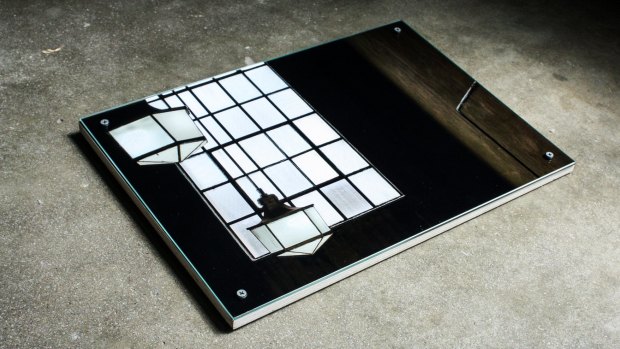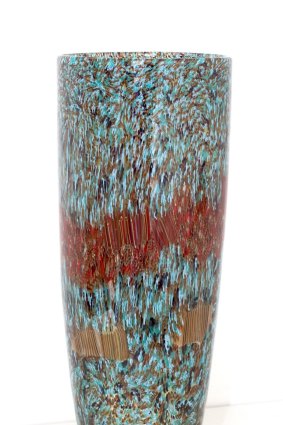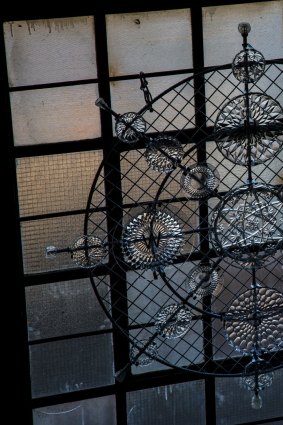This was published 6 years ago
Craft review of Home is where the heat is: A varied and arresting collection of glass
By Kerry-Anne Cousins
Home is where the heat is. Various artists. Canberra Glassworks. Until January 14.
This varied and interesting exhibition is by 25 artists who have a connection with the Canberra Glassworks. It is the 10th anniversary of the Canberra Glassworks that was established in 2007 in the old Kingston Powerhouse, one of the oldest permanent public buildings in Canberra. The Canberra Glassworks is an organisation that has become a considerable presence in the national capital providing both facilities for artists, lively exhibitions and public educational programs.

Meagan Jones and Louis Grant's soft focused, etched glass photographic prints - such as Transitory Spaces 4, 2017 - appear in Home is where the heat is at Canberra Glassworks.Credit: Meagan Jones
The works in the exhibition, Home is where the heat is, are not all in the Glassworks Gallery but are positioned in various parts of the building not normally open to the public and you will need a guided tour to see them all. The day I visited, in addition to works from the exhibition in the Glassworks' Hotshop, visitors could also see a number of glass artists at work.
Among them was Jenni Kemarre Martiniello who creates contemporary glass that is a reflection of her Indigenous heritage. Her early glass works were based on the woven structure and form of Aboriginal baskets. Confluence Landscape #1 and #2 in this exhibition are two tall, beautifully patterned and coloured vessels. The artist skilfully uses the murine glass technique to form coloured patterns that suggest the water, the vegetation and bird life of the Molonglo River and Jerrabomberra Creek near where the powerhouse now stands. Mark Elliot's remarkable glass sculptured tree (A Mind of its Own) with its small birds, bears testimony to the tree as a marker of nature that grows in the built environment.

Jennifer Kemarre Martiniello, Confluence Landscape #1: Blue Grasses, 2017, in Home is where the heat is at Canberra Glassworks.Credit: Jennifer Kemarre Martiniello
Ruth Oliphant's series of glass panels are inspired by the architecture of the powerhouse. She interprets the light that comes through the tall, glass panelled windows of the Engine Room in a series of small standing panels. Half Light, 2015, shown in the Glassworks Gallery, is one of the most successful. The work is mounted on the wall and has beneath it as a pendant another glass panel that cleverly suggests a cast shadow. Ngaio Fitzpatrick also makes use of the light from these windows by placing her large delicate glass mandala made from recycled cut glass across their panels.
Both Lucy Palmer and Rose-Mary Faulkner also work with colour and light. Palmer's small panel of kiln-formed glass (20 centimetres by 10 centimetres by 6 centimetres) with its high horizon line successfully transmits an intangible and ethereal sense of the infinity of space. Rose-Mary Faulkner's three small panels (Traced 1V) suggest the soft sensuality of the body's landscape. The image of the fingers of a hand being drawn across a surface, although it may not be the artist's intention, seems a particularly apt image for a building in which the traces of many people have been left behind.
Nikki Main's series of charcoal drawings called Meanderings: the Engine Room of an Artist Practice are soft tonal compositions of common objects including light bulbs (Light Bulb Moment), water taps (Outpouring) and maps (Dam Plan). The artist explores the analogy between common objects and the process she experiences in creative thinking. Meagan Jones and Louis Grant's soft focused, etched glass photographic prints in black and white create an atmospheric essay on the architectural features of the building. Ellen Collins' work also references the building's architectural features by casting in both clear and yellow glass the old light switches so emblematic of the former function of the powerhouse and a symbol of its industrial obsolescence.
Among other arresting works is Ursula Halpin's installation Naire Orthu, which references womens' history within an Irish and Australian context. Her open weave, lace-like forms are made in pate de verre glass. Hanging in a cluster from the gallery ceiling they move slowly in the air like thistledown. Jacqueline Knight's sculpture Flight is an enigmatic work – beautifully conceived feathered wings in sculptured glass symbolise flight yet are firmly anchored to the gallery wall. In the Smokestack Gallery, Sophia Emmett's Twenty Five Breaths is an installation of clear glass balls hung together from twisted glass rope. The work is not only stunning in its fragility and gossamer-thin glass but also emblematic of the breath that is needed to mould the hot glass.

Ngaio Fitzpatrick, Glass Mandala, 2017, in Home is where the heat is at Canberra Glassworks. Credit: Wendy Dawes